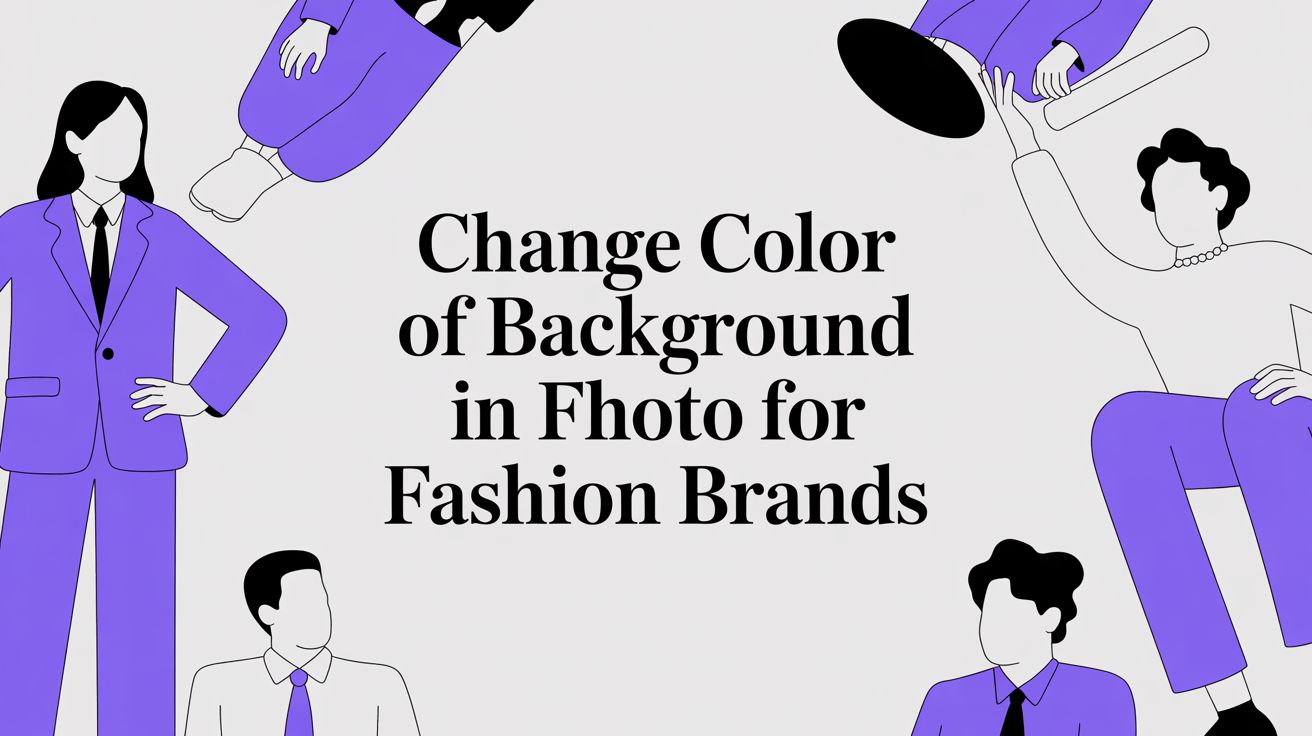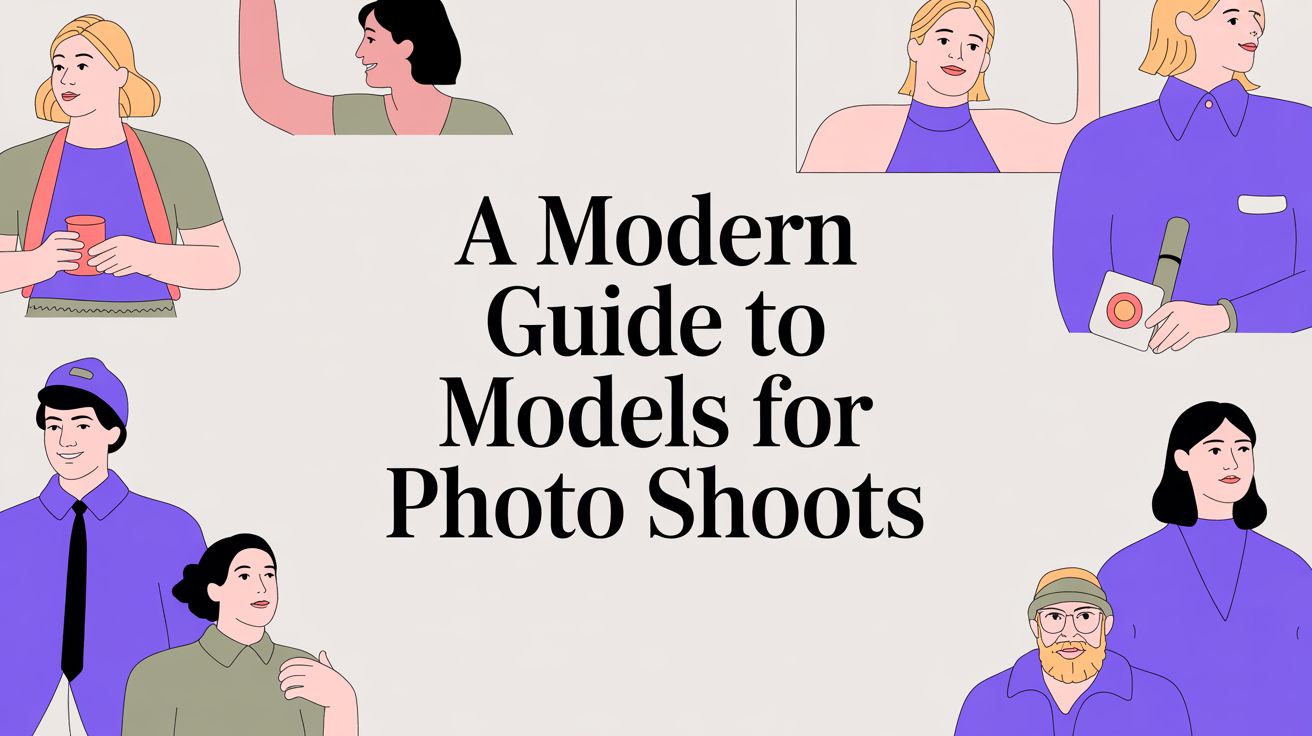How to Get Rid of Shadows in Pictures for E-Commerce
Discover how to get rid of shadows in pictures with proven lighting techniques, smart editing, and AI tools that create clean, professional product photos.
How to start saving money
Lorem ipsum dolor sit amet, consectetur adipiscing elit lobortis arcu enim urna adipiscing praesent velit viverra sit semper lorem eu cursus vel hendrerit elementum morbi curabitur etiam nibh justo, lorem aliquet donec sed sit mi dignissim at ante massa mattis.
- Neque sodales ut etiam sit amet nisl purus non tellus orci ac auctor
- Adipiscing elit ut aliquam purus sit amet viverra suspendisse potent i
- Mauris commodo quis imperdiet massa tincidunt nunc pulvinar
- Adipiscing elit ut aliquam purus sit amet viverra suspendisse potenti
Why it is important to start saving
Vitae congue eu consequat ac felis placerat vestibulum lectus mauris ultrices cursus sit amet dictum sit amet justo donec enim diam porttitor lacus luctus accumsan tortor posuere praesent tristique magna sit amet purus gravida quis blandit turpis.

How much money should I save?
At risus viverra adipiscing at in tellus integer feugiat nisl pretium fusce id velit ut tortor sagittis orci a scelerisque purus semper eget at lectus urna duis convallis. porta nibh venenatis cras sed felis eget neque laoreet suspendisse interdum consectetur libero id faucibus nisl donec pretium vulputate sapien nec sagittis aliquam nunc lobortis mattis aliquam faucibus purus in.
- Neque sodales ut etiam sit amet nisl purus non tellus orci ac auctor dolor sit amet
- Adipiscing elit ut aliquam purus sit amet viverra suspendisse potenti
- Mauris commodo quis imperdiet massa tincidunt nunc pulvinar
- Adipiscing elit ut aliquam purus sit amet viverra suspendisse potenti
What percentage of my income should go to savings?
Nisi quis eleifend quam adipiscing vitae aliquet bibendum enim facilisis gravida neque. Velit euismod in pellentesque massa placerat volutpat lacus laoreet non curabitur gravida odio aenean sed adipiscing diam donec adipiscing tristique risus. amet est placerat imperdiet sed euismod nisi.
“Nisi quis eleifend quam adipiscing vitae aliquet bibendum enim facilisis gravida neque velit euismod in pellentesque massa placerat”
Do you have any comments? Share them with us on social media
Urna ut fermentum imperdiet lacus, elementum etiam maecenas libero nunc, suspendisse massa, nisl, elit curabitur feugiat in quis ut nibh enim in tristique aliquam sed vitae dui, dis adipiscing pharetra aliquam turpis turpis nibh rhoncus enim, pellentesque leo laoreet neque in sed bibendum fermentum suspendisse tempus non purus adipiscing suscipit fringilla adipiscing convallis dolor nulla fermentum facilisis ullamcorper ut vehicula tortor libero metus donec velit, tristique fermentum, dictum euismod diam scelerisque enim non pharetra tristique lectus habitant pharetra est id
The fastest way how to get rid of shadows in pictures is to use a large, diffused light source — like a softbox — to wrap your product in even light during the photoshoot. If you're fixing images in post-production, AI-powered tools like Picjam can automatically erase unwanted shadows with a single click, a process that once took hours of manual retouching.
How Shadow-Free Images Cut Return Rates by Up to 30%
Harsh, distracting shadows aren't just an aesthetic issue — they're a direct hit to your conversion rates and a major driver of costly returns.
When a customer is scrolling, shadows can completely change how a garment looks. They muddy the true color, hide the texture of the fabric, and distort the fit.
This creates uncertainty, and uncertainty is the number one killer of online sales. It leads to abandoned carts and, worse, returns.
Fast-fashion powerhouses like Zara and SHEIN have mastered this. Their product pages feature clean, bright, and evenly lit photos that show the product exactly as it is. This is a deliberate strategy to build trust and make the buying decision as easy as possible.
The True Cost of Bad Lighting
The financial damage from poor photography is staggering. Every shadow that conceals a seam or throws off a color increases the odds of a customer getting something they didn't expect.
According to Vogue Business, returns cost U.S. retailers an eye-watering $816 billion in 2022 alone. A huge chunk of that comes from products not matching their online photos.
- Lost Sales: Shoppers are 40% more likely to click away if product images are unclear or look unprofessional.
- Skyrocketing Returns: When a product doesn't match its photo, it comes right back. That eats away at your profit margins with every return label.
- Brand Damage: Inconsistent, amateur-looking photos make your whole brand feel less credible.
Impeccable product photography isn't just a nice-to-have; it's a core part of any serious e-commerce growth strategy{:target="_blank"}. It's the first, and most important, handshake you have with a potential buyer.
How AI Delivers Marketplace-Ready Photos in Minutes
Getting that clean, studio-quality look used to mean expensive equipment and hours of painstaking manual retouching. AI is leveling the playing field, making professional results accessible and affordable.
Platforms like Picjam automate this entire workflow. You can upload a basic product shot and instantly get back a perfectly lit, shadow-free image that's ready for any marketplace.
The AI can intelligently relight the product, creating a soft, natural look that brings out the details without making it look flat or fake. Listings that use balanced, AI-enhanced images have seen engagement jump by as much as 32%.
These tools can slash editing time by nearly 70% compared to manual work, which is a massive win for your operational costs. This efficiency means you can get products to market faster, react to trends, and ultimately, sell more.
Control Shadows Before You Press the Shutter
The absolute best way to deal with shadows is to stop them from ever showing up in the first place. Post-production software is powerful, but getting it right on set saves an incredible amount of time and gives you a much cleaner, more professional final image.
Learning how to get rid of shadows in pictures really begins with understanding light. Harsh, direct light from a small source creates sharp, dark shadows. The fix? Large, diffused light sources. These create soft, gentle shadows that wrap around your product, revealing texture and detail without being a distraction.
It's a simple concept, but the impact on your sales is direct and measurable. Fixing harsh shadows can transform a poor-performing product listing into a top-seller.
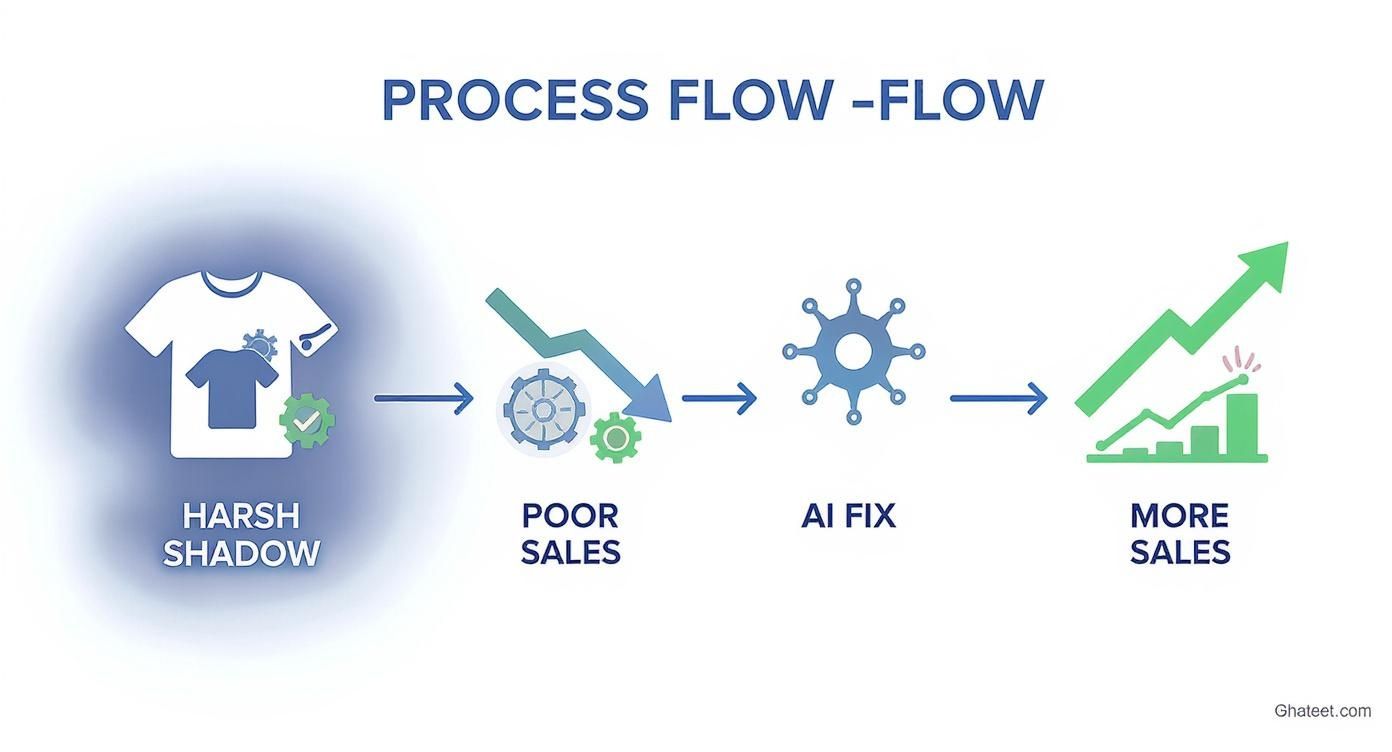
Whether you address shadows on set or clean them up later with AI, the goal is the same: improve the product presentation to drive better sales performance.
On-Set Lighting Setups for Shadow Control
Your lighting setup is the single most important factor in controlling shadows. The goal for apparel is almost always the same: create soft, even light that flatters the fabric. Here’s a look at a few common techniques.
While a three-point setup gives you ultimate control, even a single large light source and a reflector can produce stunning, professional results. The key is to diffuse your light source to make it as large and soft as possible relative to your product.
The Gear That Gets It Done
The number one enemy of good apparel photography is a small, bare flash. It creates nasty, hard-edged shadows that make fabric look cheap. Instead, you'll want to modify your light source to make it bigger and softer.
Here's what works:
- Softboxes: These are the workhorses of product photography. A large octagonal or rectangular softbox takes the harsh light from your strobe and spreads it out, effectively making your light source massive.
- Umbrellas: A shoot-through or reflective umbrella achieves a similar effect, scattering light over a wide area for gentle, even illumination. They're often faster to set up than softboxes.
- Natural Light: Don't underestimate a big, north-facing window on an overcast day. This is nature's softbox, and it's free. Just use a simple white reflector card to bounce light back into any areas that look too dark.
Tweak Your In-Camera Settings
Even the best lighting setup can be undermined by the wrong camera settings. Getting your exposure right in-camera is non-negotiable for clean, professional shots.
First, always shoot in RAW format. JPEGs throw away a ton of image data. RAW files capture everything, giving you more wiggle room to recover details from shadows or highlights in post-production.
Next, nail your exposure triangle:
- ISO: Keep it as low as possible, usually ISO 100 or 200. Bumping up the ISO makes your sensor more sensitive to light, but it comes at a cost: digital noise, which loves to hang out in the shadow areas.
- Aperture: A mid-range aperture like f/8 or f/11 is often the sweet spot. It provides enough depth of field to keep the entire garment in sharp focus while letting in a good amount of light.
- Shutter Speed: With your camera on a tripod (and you should absolutely be using a tripod), you can use a slower shutter speed to let in more light without worrying about camera shake.
For anyone shooting a high volume of products, a dedicated product photography light box can be a game-changer. These all-in-one studios have built-in diffused lighting, which simplifies the entire process and guarantees consistent, shadow-free results every single time.
Taking the Reins: Manually Removing Shadows in Photoshop and Lightroom
While AI tools are incredibly fast, sometimes you need the granular control that only manual editing can deliver. For those moments when pixel-perfect precision is the only option, industry workhorses like Adobe Photoshop{:target="_blank"} and Lightroom{:target="_blank"} are your best friends.
Mastering these isn't just about deleting shadows; it's about learning to shape light in a way that truly elevates your product.
Imagine a close-up of a textured Allbirds sneaker. A harsh shadow falls right across the wool, hiding that intricate knit and making the color look dull. A skilled editor can fix this, turning a good photo into one that accurately represents the product and drives sales.
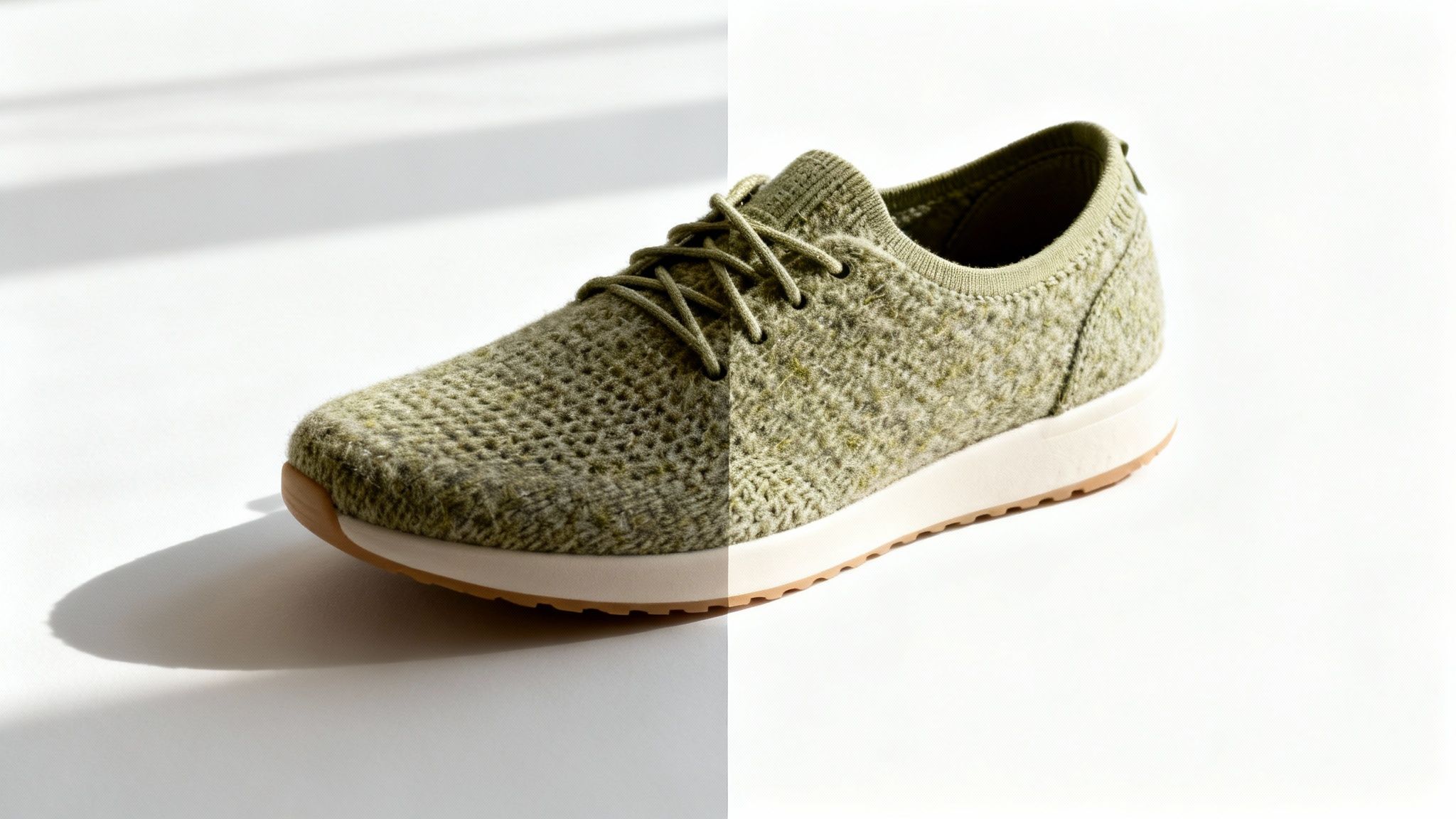
Photoshop Techniques for Precise Shadow Control
Photoshop gives you a whole toolkit for surgical-level shadow removal. The key here is to work non-destructively. Always use layers and masks so you can dial back your edits at any time. This preserves your original image data and gives you total flexibility.
A classic technique is dodging and burning. Create a new layer, fill it with 50% gray, and set its blend mode to Overlay. Now, grab a soft, low-opacity brush. Paint with white to "dodge" (lighten) the shadow or with black to "burn" (darken) other areas to add contrast.
Another go-to is the Curves Adjustment Layer. By creating a new Curves layer, you can use its layer mask to precisely target only the shadowed area. Gently lift the curve to brighten the shadows, being careful not to push it too far. The beauty of this method is its precision.
Lightroom for Efficient Shadow Adjustments
When you're dealing with huge product catalogs, Lightroom offers a much faster workflow for shadow correction. It might not have the same layered complexity as Photoshop, but its tools are more than powerful enough for most e-commerce needs.
The hero here is the Adjustment Brush. Just select the brush, nudge the Shadows and Exposure sliders up a bit, and then paint directly over the areas you want to lift. You can tweak the brush's size, feather, and flow to control the effect with surprising precision.
And don't forget the global Shadows and Blacks sliders in the Basic panel. Often, a slight bump to the Shadows slider is all you need to open up darker areas across the photo, giving you a quick and effective fix.
Avoiding the Dreaded "Flat" Look
The single biggest risk when removing shadows is creating an image that looks flat and totally unnatural. Shadows are what give objects depth and form. When you remove them completely, a product can look like a two-dimensional cutout pasted onto a background.
The goal should be reduction, not complete elimination. You want to soften the harsh, distracting shadows while keeping the gentle, form-defining ones.
Stick to these best practices:
- Work Gradually: Always use low-opacity brushes and make small, incremental adjustments.
- Maintain Contrast: As you lighten shadows, you might need to subtly add contrast back in other areas to keep the image looking punchy.
- Zoom Out Frequently: Constantly check your work at a normal viewing size to ensure edits look natural.
Getting this right has always been a high-level skill. Years ago, researchers were already exploring statistical parameters to measure image clarity. You can discover more about these early technical approaches{:target="_blank"} to see just how far the technology has come.
Manual editing gives you unparalleled control, but it comes at the cost of time and expertise. This is where AI tools are changing the game, offering a scalable alternative that delivers near-perfect results in a fraction of the time.
How AI Slashes Photo Editing Costs for Brands Like Crocs
Manual editing, for all its pixel-perfect control, is a huge bottleneck for brands that need to move fast. Every hour a skilled retoucher spends lifting shadows is a direct hit to the budget. This operational drag is exactly where AI-powered platforms are making a massive difference.
AI steps in to automate the tedious, repetitive tasks that used to eat up hours of manual labor. For fashion brands, this means getting rid of unwanted shadows, swapping out backgrounds, and even relighting products — all in a few clicks.
Think about a brand like Crocs, with its seemingly endless rainbow of colors and patterns. They need thousands of unique product shots, each perfectly consistent and lit for every marketplace.
The old way would mean endless hours of repetitive editing. With an AI platform like Picjam, the whole equation changes. You can upload a single photo of a new shoe and instantly generate dozens of variations, each with pristine lighting and zero distracting shadows.
The Automation Advantage in Numbers
This move toward AI-driven editing isn't just a fleeting trend; it’s a shift driven by the bottom line. The global photo editing software market was valued at $449.2 million in 2023 and is on track to hit $886.2 million by 2032. A huge chunk of that growth is from AI tools.
So, what does this actually mean for a fashion brand's budget?
- Drastically Reduced Editing Hours: Tasks that would tie up a freelancer for 4-5 hours can now be completed in under 5 minutes.
- Lower Freelance and Agency Costs: Brands can cut back on pricey external retouching services, bringing more of the workflow in-house.
- Faster Time-to-Market: You can get products from the photoshoot to the product page in the same day, letting brands jump on trends faster.
From Mediocre Lighting to Perfect Product Shots
One of the most powerful things AI can do is intelligent relighting. Lots of brands have photos that are technically okay, but they lack that bright, even lighting that e-commerce demands.
AI can look at an image, identify the product, and digitally add new light sources to create that perfect studio feel. It can fill in underexposed areas, add a gentle key light to make details pop, and ensure the entire garment is lit consistently.
This saves brands from the headache and cost of reshoots. What was once a sunk cost becomes a valuable asset, ready to drive sales. You can get a closer look at how this all works in our complete guide to AI product photography.
Shaping the Future of Fashion Content
This cost-saving angle is fundamentally changing how modern fashion brands operate. Founders and marketers can now experiment with more creative ideas without worrying about a massive production bill.
Want to see how a new handbag looks against a dozen different lifestyle backdrops? AI can generate those mockups in seconds.
AI is also making waves in other crucial areas, like optimizing the text on product pages. For a deeper dive, check out resources on AI content optimization for e-commerce{:target="_blank"}. This technology lets brands be more agile and creative, all while keeping a tight grip on production costs.
Ensuring Visual Consistency Across Your Sales Channels
For any fashion brand, consistency isn't just nice to have — it's the bedrock of your identity. When a shopper sees your product on Amazon, then your Shopify store, and later on ASOS, that visual experience has to be seamless.
Any little difference in lighting, background, or shadow style can create a jarring disconnect that feels unprofessional and erodes trust.
Keeping everything uniform is a huge operational headache. Every single image needs to follow your brand guidelines and the strict rules of third-party marketplaces. If you don't, you risk suppressed listings and a disjointed customer experience.
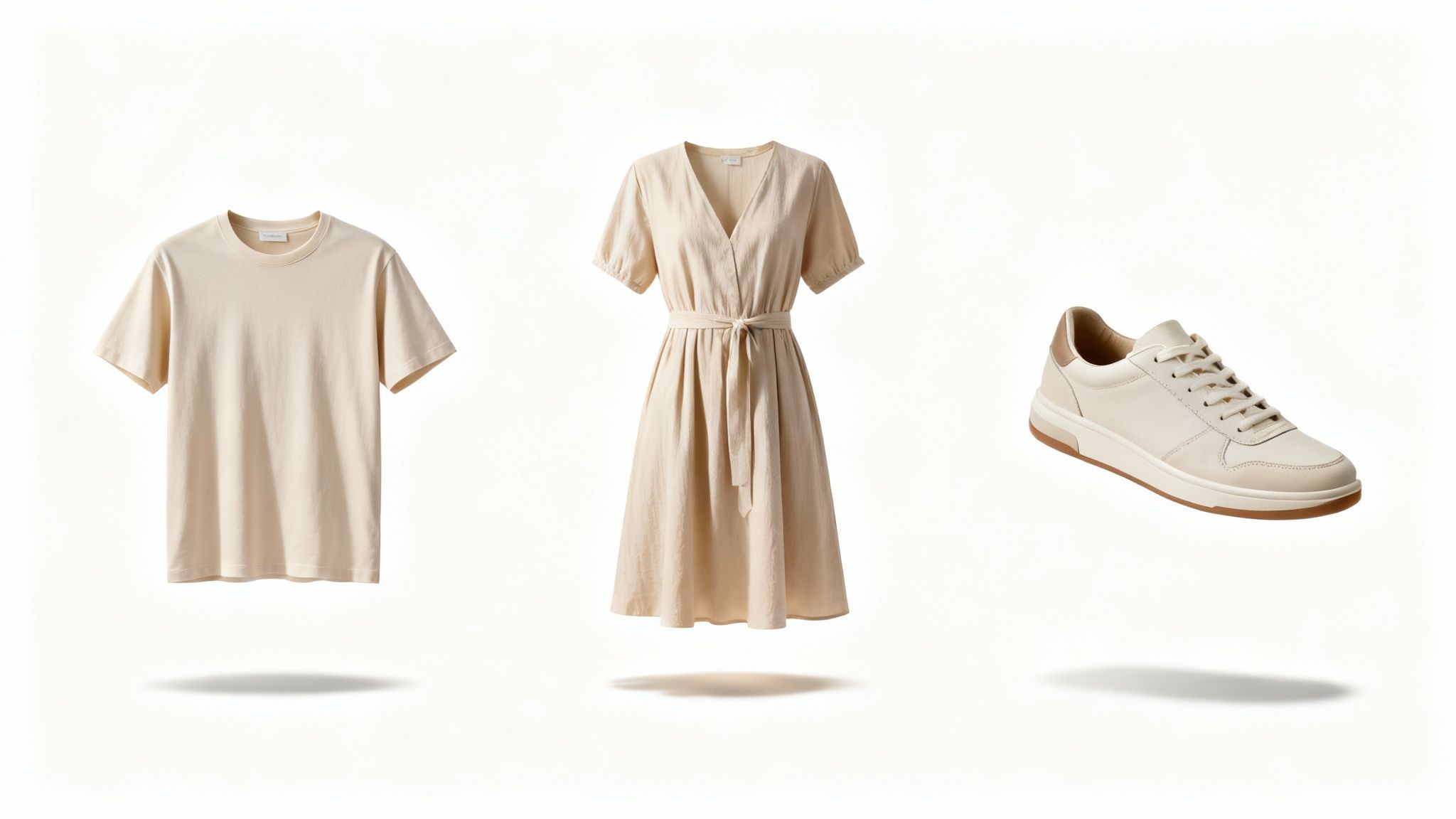
Building Your Visual Quality Assurance Framework
Think of a strong QA framework as your brand's visual rulebook. It’s what ensures every photo hits the same cohesive standard. This is particularly important when figuring out how to get rid of shadows in pictures, because you need one consistent approach.
Your framework should spell out the non-negotiables:
- Background Color: For most marketplaces, this is pure white (#FFFFFF). Specify the exact hex code to take all the guesswork out of it. This makes your products pop and creates a clean, professional catalog.
- Lighting Style: Get specific. Is the goal a bright, even look with zero visible shadows? Or do you want a soft, subtle drop shadow? A brand like Nike, for instance, uses incredibly crisp, even lighting to show off every technical detail.
- Shadow Standards: Decide on a shadow policy and stick to it. Are soft, natural-looking contact shadows okay, or do all images have to be completely shadow-free? Documenting this from the start stops inconsistent editing choices.
According to Statista, the global e-commerce fashion market is on track to blow past $1.3 trillion by 2028. In a market that competitive, visual consistency is one of the most powerful ways to stand out.
The Power of Batch Processing with AI
Manually checking every single image against your QA framework doesn’t scale. This is where AI-powered batch processing goes from a "nice-to-have" to an essential tool for any modern fashion brand.
Platforms like Picjam let you apply your entire visual framework to hundreds of photos all at once.
Imagine you're launching a new collection of 50 handbags. Instead of an editor opening each file, you can just upload the whole folder and apply a preset. Within minutes, every image is returned perfectly compliant.
The efficiency gains here are massive. It slashes the time spent on manual QA, cuts down on human error, and ensures every asset is marketplace-ready right out of the gate.
Standardizing Your Product Backdrops
A consistent backdrop is one of the quickest ways to elevate your visual branding. While pure white is the e-commerce gold standard, the real goal is to make it look effortless across your entire product line.
To dive deeper into making this happen, check out our guide on choosing the right product photography backdrop.
AI tools are a game-changer here. They can instantly remove cluttered or off-color backgrounds and replace them with your specified hex code. This is how you ensure that a t-shirt photographed in May looks like it belongs right next to a coat shot in September.
A solid QA process, supercharged by the efficiency of AI, turns visual consistency from a creative headache into a streamlined, automated workflow. It saves money, gets your products to market faster, and strengthens your brand identity.
Got Questions? We’ve Got Answers.
When you’re trying to nail that perfect, shadow-free look across thousands of product shots, a few questions always pop up. Here’s some straight talk on the common hurdles apparel brands face and how to clear them.
What’s the Fastest Way to Get Rid of Shadows in Pictures?
If you're dealing with more than a handful of images, editing them one by one is a massive time sink. Your fastest route is an AI-powered editor built for bulk work.
Platforms like Picjam let you drag and drop an entire photoshoot, then apply consistent shadow removal and relighting effects across the board. The whole process takes minutes, not hours.
For a giant like ASOS that uploads a dizzying number of new products daily, this kind of speed isn't just nice — it's absolutely essential.
Can AI Remove Shadows Without Making My Product Look Flat?
Absolutely. This used to be a real problem, but modern AI has gotten incredibly smart. It’s no longer just a blunt tool that erases shadows and leaves a flat, lifeless cutout.
Today’s advanced algorithms analyze the shape and texture of your garment. When they remove a harsh shadow, they can intelligently add back subtle, realistic ambient occlusion or a soft drop shadow.
This makes the product look grounded and three-dimensional, preserving that tactile quality that’s so critical for selling fashion online.
Will Removing Shadows Change the Original Color of My Apparel?
This is a big one. Getting the color right is non-negotiable in fashion.
The good news is that both professional manual techniques and high-quality AI tools are designed to protect color integrity. They work by targeting the luminance (brightness) of the shadowed area, leaving the hue and saturation alone.
That said, I always recommend a final color check against the physical garment. It’s a simple last step that ensures what your customers see is exactly what they get.
Takeaway
- Prevent Shadows on Set: The cheapest and fastest way to deal with shadows is to stop them from showing up in the first place. Use a large, diffused light source to save time and money in post-production.
- Automate Your Editing: For brands dealing with hundreds of products, a manual workflow with Photoshop{:target="_blank"} doesn’t scale. AI-powered tools like Picjam automate shadow removal and background cleanup, slashing editing costs and getting products online faster.
- Create a Visual Style Guide: Define your rules for lighting, backgrounds, and shadow handling. This ensures a cohesive, professional look across your entire store and simplifies compliance with marketplace image requirements.
Curious how much your brand could save by automating shadow removal and other tedious editing tasks? Compare Picjam with what you're currently spending on photography and see exactly what a difference AI can make.
Use our savings calculator to see the numbers stack up.
Picjam team
Pellentesque leo laoreet neque in sed bibendum fermentum suspendisse tempus non purus adipiscing suscipit fringilla adipiscing convallis dolor nulla fermentum facilisis ullamcorper ut vehicula tortor lib.


